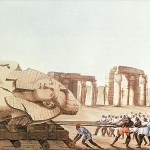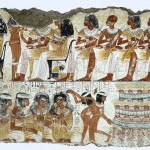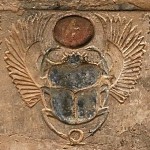Libyan Desert Glass and the Breast Ornament of Tutankhamen
One of the many fabulous items in the jewellery collection from the tomb of Tutankhamen is a breast ornament. A highly decorative piece in the form of a winged scarab, dating to around 1330 BCE, it is currently on display in the Egyptian Museum in Cairo (JE 61884; Burton Photo No. P1133; Carter No. 267d). Adorned with silver, semi-precious stones and glass paste, all set into gold, the eye-catching centrepiece is a semi-translucent green scarab. Remarkable for its beauty, the pectoral has the added interest of scientific and archaeological mysteries that have yet to be completely unraveled. [more…]

In Defense of Belzoni
The early explorers of Egypt, often associated with ideas of adventure, discovery and buried treasure, fascinate many people interested in the earliest days of Egyptology. No name elicits a stronger, and often negative reaction from scholars than that of Giovanni Belzoni, who explored Egypt in the early 1800s. Belzoni has often been depicted as a villain, an irresponsible treasure hunter who destroyed valuable antiquities as he blazed through Egypt in a search for gold. It is this image of Belzoni that forms many people’s preconceptions. [more…]
Book Review: The Lost Tombs of Saqqara
Consisting of eight chapters, the main attraction of The Lost Tombs of Saqqara is the exceptional beauty of the photographs. For those unfamiliar with the site, Saqqara is a vast, sprawling necropolis to the south of Cairo. It was used from the Early Dynastic period onwards for royal and elite burials, and is best known for the Step Pyramid of Djoser, Egypt’s earliest pyramid, and its other Old Kingdom pyramids and beautifully decorated mastaba tombs. This book takes the reader into the New Kingdom area of Saqqara. [more…]
AWT Conference 2011 – Excavating in the Valley of the Kings (Stephen Cross)
As described in the overview of the 2011 AWT Conference co-authored with Andrea Byrnes, the closing keynote lecture was delivered by Stephen Cross. His lecture created a buzz in the room and that has continued since Andrea Byrnes and I first posted about it on our respective blogs. In this account of his lecture, I shall present the theory as described by Cross: this is intended as reportage not as as detailed critique, although obviously a certain level of commentary is included. [more…]
Book Review: History of Ancient Egypt: Neolithic Period ot the Early Dynastic Period including Menes, Narmer, Hieroglyphs, Thinis and More.
By Andrea Byrnes. Published on Egyptological, 9th September 2011 History of Ancient Egypt: Neolithic Period ot the Early Dynastic Period including Menes, Narmer, Hieroglyphs, Thinis and More. Edited by Grace Windsor ISBN 9-781241314675 This is a self-published book, one in a series about Ancient Egypt, widely available on online book stores. Before I […] [more…]
Course Review: The SACE Beginner and Intermediate Hieroglyphs course 2011
The SACE Ancient World Summer School “Beginner and Intermediate Hieroglyphs” course ran for a week in August this year. Three of those attending the course offered to write up a summary of their experiences on the course. With different backgrounds and levels of confidence they have provided an insight into their perceptions on the value and challenges of the course. Our thanks to them for sharing their thoughts. [more…]

Egyptological Magazine – Edition 2
Welcome to the Second Edition of the Egyptological Magazine
In the Magazine we are pleased to see the return of two authors from the first edition. Brian Alm is continuing his popular series on the religion of the ancient Egyptians while Barbara O’Neill returns with another lavishly illustrated article. The image alongside, from the tomb of Nebamun is just one of the images in her article on the depiction of animal companions in tombs. We are delighted to welcome two new authors. Philip A. Femano has written a must-read article questioning the purpose of the blocking stones in the Ascending Passage of the Great Pyramid. Gary Beuk presents a biography of one of the best known early Egyptologists, and certainly the most colourful, Gionanni Battista Belzoni. Andrea Byrnes has added an article on the little known subject of Libyan Desert glass, a real treat for any Tutankhamun fans who have not heard of this unusual material found amongst his jewelery. We hope you will show your appreciation for all of our writers by leaving comments on their pieces. Our plan is for the Magazine to feature reviews as well as articles and you will find three of those as well, written by us. We attended the AWT conference last weekend and offer an overview and the first of our detailed reviews of invidual lectures. More will follow over the next few weeks. [more…]
Help required identifying photos from Abusir
A query from Pat Kennedy: A few years ago I made a visit to the Abusir pyramid field but fear that my photos have become mixed up and I don’t know what I took, where. I am sure of the provenance of the Sahure pyramid picture but I think the other two may have been […] [more…]
Upcoming: Edition 2, September 9th 2011
On Friday 9th September 2011 Edition 2 of the Magazine section of Egyptological will be published. The second edition of the Journal will be published at the end of the month, with details to follow. With five articles in the Magazine Articles section, a book review in Magazine Reviews and a new Photo Album in […] [more…]

 By
By